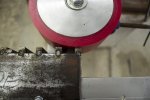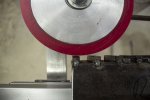Alrighty, here's where I'm at with this project. I did not need to cut the aluminum bar stock into 2 arms, but I wasn't sure how the wheel would line up with the chuck. I was expecting to have to offset it, but wouldn't you know it, it landed almost perfectly where it should be.
I decided to use a thick piece of angle iron as the chuck and steel square stock to make the slots. As you can see, the chuck is crooked by about .030 from end to end. I drilled the holes in the angle iron slightly off

Do I try to fix this by re-drilling the holes, or would surfacing the chuck (as I need to anyway) fix the issue? I could also shim the connection between the 2 arms when I bolt them together.
Overall, if you don't count the aluminum bar stock that I did not use for the chuck, I'm in this thing for $350. Not a bad cash savings over a $1k prebuilt. Still need to buy a dial indicator so I can see how much each pass is taking off. In initial testing with the 2 arms clamped together, I am rounding off edges badly, but I know that the chuck hasn't been surfaced yet and I'm likely taking too much per pass.
View attachment 1651612View attachment 1651613View attachment 1651614View attachment 1651615




 Do I try to fix this by re-drilling the holes, or would surfacing the chuck (as I need to anyway) fix the issue? I could also shim the connection between the 2 arms when I bolt them together.
Do I try to fix this by re-drilling the holes, or would surfacing the chuck (as I need to anyway) fix the issue? I could also shim the connection between the 2 arms when I bolt them together.




